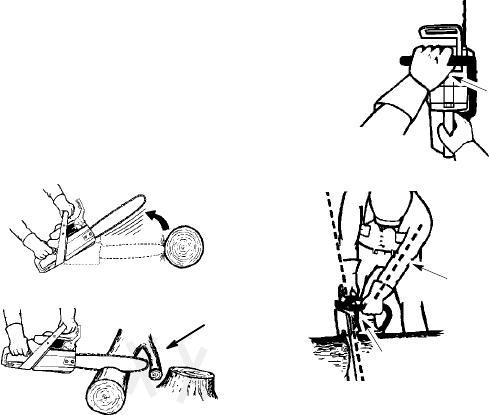
4
S Pinch-Kickback can occur when the the
wood closes in and pinches the moving
saw chain in the cut along the top of the
guide bar and the saw chain is suddenly
stopped. This sudden stopping of the
chain results in a reversal of the chain
force used to cut wood and causes the
sawtomoveintheoppositedirectionofthe
chain rotation. The saw is driven straight
back toward the operator.
S Pull-In can occur when the moving chain
contacts a foreign object in the wood in the
cut a long th ebottom o fthe guid ebar andthe
saw chain i s suddenly stopped. This sudden
stopping pulls the saw forward and away
from th eoperatorand could easily causethe
operator to lose control of the saw .
Avoid Pinch--Kickback:
S Be extremely aware of situations or ob-
structions thatcancausematerialtopinch
the top of or otherwise stop the chain.
S Do not cut more than one log at a t ime.
S Do not twist the saw as the bar is with-
drawn from an undercut when bucking.
Avoid Pull--In:
S Alwaysbegin cuttingwiththeengineatfull
speed andthesaw housingagainstwood.
S Use wedges made of plastic or wood.
Never use metal to hold the cut open.
Kickback Path
A
void Obstructions
Clear The Working Area
REDUCE THE CHANCE OF
KICKBACK
S Recognize that kickback can happen.
With a basic understanding of kickback,
you can reduce the element of surprise
which contributes to accidents.
S Neverletthemovingchaincontactanyob-
ject at the tip of the guide bar .
S Keep the working area free from obstruc-
tionssuchasothertrees,branches,rocks,
fences, stumps, etc. Eliminate or avoid
any obstruction thatyour saw chain could
hit while you are cutting. When cutting a
branch, do not let the guide bar contact
branch or other objects around it.
S Keep your saw chain sharp and properly
tensioned. A loose or dull chain can in-
crease the chance of kickback occurring.
Follow manufacturer’ s chain sharpening
andmaintenanceinstructions. Checkten-
sion at regular intervals with the engine
stopped, never with the engine running.
Make sure the chain brake nuts are se-
curelytightenedaftertensioningthechain.
S Begin and continue cutting at full speed. If
the chain is m oving at aslower speed, there
is greater chance of kickback occurring.
S Cut one log at a time.
S Use extreme caution when re-entering a
previous cut.
S Do not attempt cuts starting with the tipof
the bar (plunge cuts).
S Watch forshifting logs orother forces t hat
could close a cut and pinch or fall into
chain.
S Use the Reduced--Kickback Guide Bar
and Low--Kickback Chain specified for
your saw.
MAINTAIN CONTROL
Never reverse
hand positions
Stand tothe
left of the saw
Thumb on
underside of
handlebar
Thumb on underside of
handlebar
Elbow locked
S Keep a good, firm grip on the saw with both
hands when the engine is running and don’t
let go. A firm grip will help you reduce kick-
back and maintain control of the saw. Keep
the fingers of your left hand encircling and
your left thumb under the front handlebar .
Keep your right hand completely around the
rear handlewhether your ar erighthandedor
left handed. Keep your left a rm straight with
the elbow locked.
S Position yourlefthandonthe f ronthandle-
bar so it is in a straight line with your right
hand on the rear handle when making
bucking cuts. Never reverseright andleft
hand positions for any type of cutting.
S Standwithyourweightevenlybalancedon
both feet.
S Stand slightly to the leftside of the saw to
keep your body from being in a direct line
with the cutting chain.
S Do notoverreach. You could bedrawn or
thrown off balance and lose control of the
saw.
S Donotcutaboveshoulderheight. Itisdiffi-
cult to maintain control of saw above
shoulder height.


















